Exactly one year ago, Apple brought forth the iPhone App Store, which has gone on to become the greatest gift to Twitter’s growth imaginable. Among other things.
Let’s hope they have it really perfected by next year.
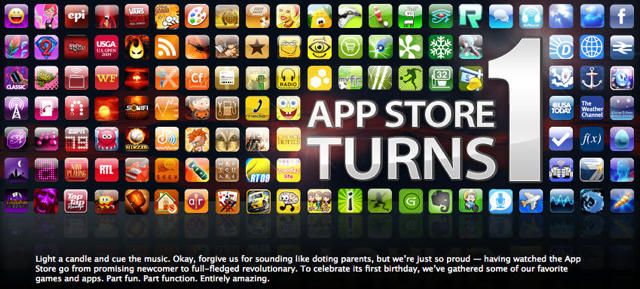
Exactly one year ago, Apple brought forth the iPhone App Store, which has gone on to become the greatest gift to Twitter’s growth imaginable. Among other things.
Let’s hope they have it really perfected by next year.
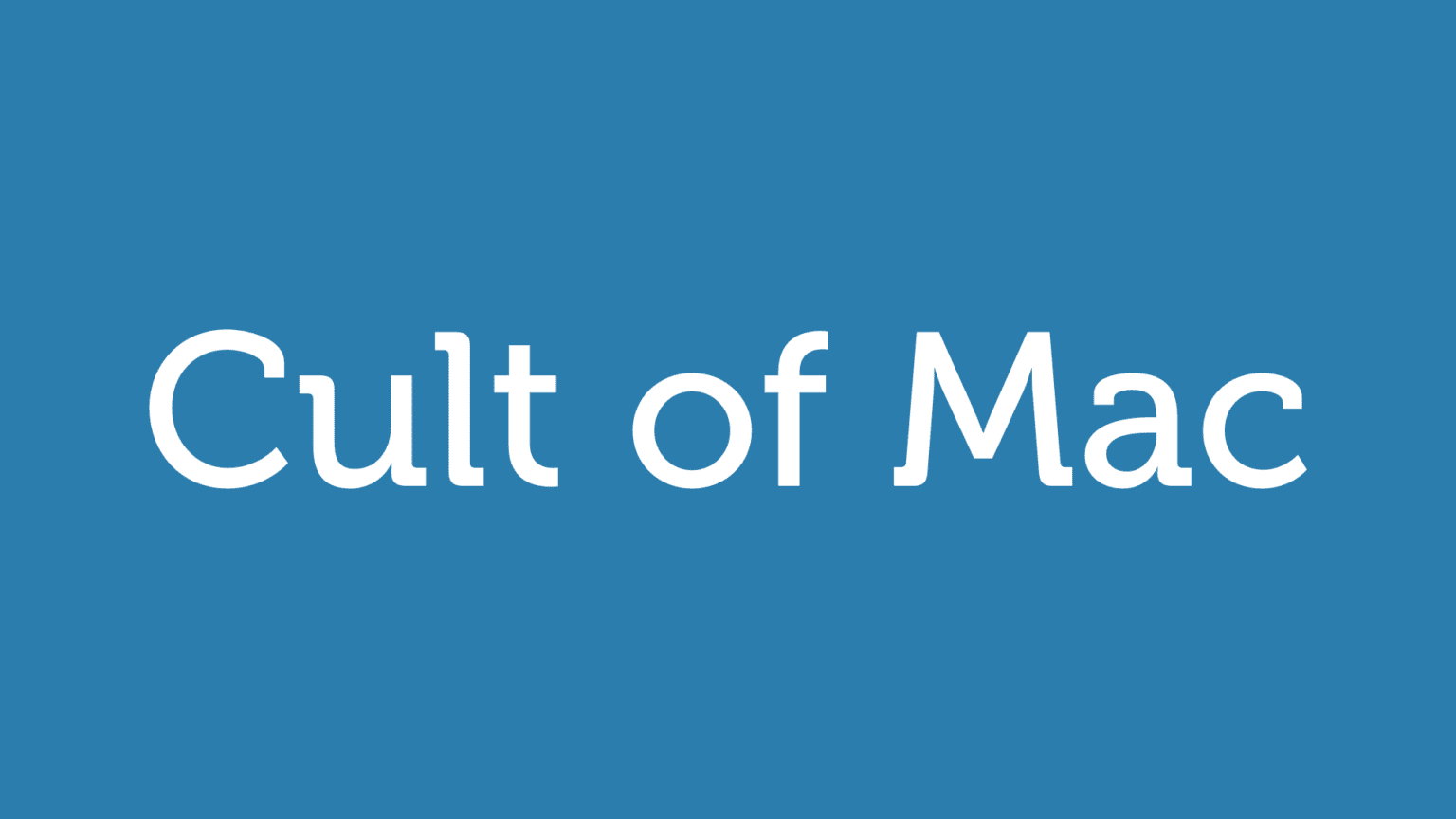
Hyperwall in WWDC 2009, Live from App Store from Imagebakery on Vimeo.
By all accounts, the iPhone 3GS launch has been a tremendous success for Apple. Despite launching in a down economy, the new model managed to sell as many units in its first weekend as its predecessor with little sign of slowdown. It’s also been an incredibly smooth launch. Though the iPhone 3G launch was marred by product shortages and buggy software, Apple’s kept a steady supply of hardware in the channel, and iPhone OS 3.0 is quite stable for such a new release.
But as effective as Apple has become in managing all of the aspects of the iPhone that it controls (hardware and first-party software), the launch also reveals the challenges the company faces in its efforts to take advantage of a larger network. AT&T’s signal strength continues to be a subject of much heated debate, and more crucially, Apple’s position as minder of a large software platform with thousands of developers looks increasingly untenable.
I don’t need to go into detail about the numerous cracks in the App Store facade of the last year: the baby shaking app, the unapproved porn, the copyright infringement, the excellent apps inexplicably rejected for arbitrary reasons and the apps that never made it out of the approval process one way or another. What I can say is this: the release of the 3GS has inspired a burst of app submissions the likes of which Apple has never seen before. When the App Store first opened a year ago, it had a flurry of submissions, but a smaller pool of developers. This is the first real “event” period since the iPhone dev community has grown, and the submission pool is not unlike the giant hyperwall of apps that dominated the conversation at this year’s WWDC.
A developer friend tells me that a pre-release version of his app was checked off and approved in a week in the period immediately before the 3GS announcement. The final release, submitted the day of the WWDC keynote on June 8, took nearly four weeks to get through the system, and I’m told that Apple has even notified its developer community that all apps are taking between three and four weeks to vet. That means it takes four times as long to get new products to consumers, four times as long to fix bugs, and four times as long to go from finished work to money-making.
If Apple wants to maintain the dominance of the iPhone and the success of the App Store, it needs to find a more effective way to manage the sheer volume of submissions it’s tackling. Too much crud is making it through, and too much brilliant code is sitting on the shelf. The iPhone is by far the best mobile platform today. Unless Apple learns to treat its developers better on the front end (I hear payment works brilliantly), they won’t be loyal when the next Next Big Thing comes around.
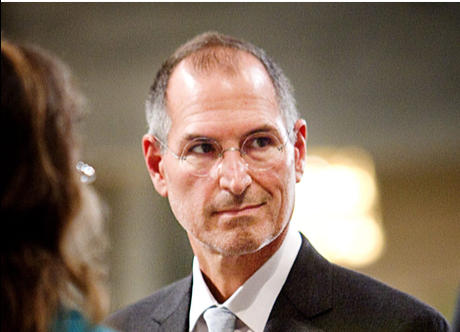
Fast Company co-founder Bill Taylor has sparked a bit of a controversy on his Harvard Business Review blog by suggesting the heretical idea that — shock! — Steve Jobs might not be the best role model for other business leaders.
Apparently, it’s deeply offensive to suggest that what makes Steve great are the exact qualities that typically make for bad management at most companies. He micro-manages every aspect of Apple, has been known to fire people with minimal cause, and perennially runs the risk of out-shining his company — which is particularly problematic when his health problems continue to cast into doubt his long-term prospects as CEO.
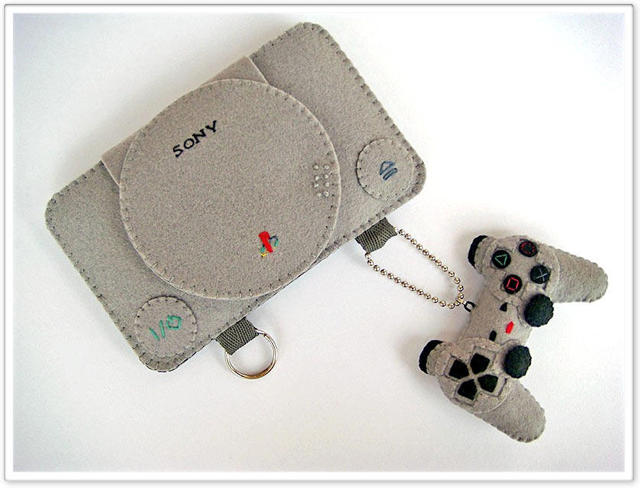
I don’t know why, but a felt representation of a beloved gaming platform designed as a case for my current most-beloved gaming platform? Just makes me sigh. Isn’t it dreamy?
Etsy via iPhone Savior via Gizmodo
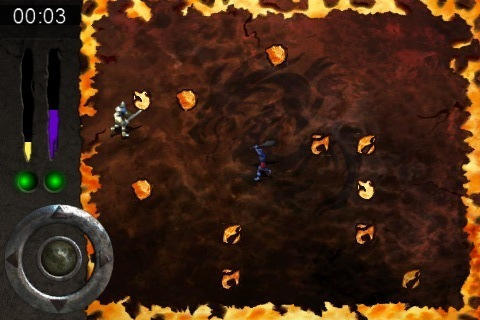
What it is: Archon Classic is an iPhone app that brings my favorite-ever Mac game to the iPhone — perfectly. It’s basically like extraordinarily Manichean version of chess — the battle between not just white and black pieces, but light and dark forces. And instead of merely taking other pieces as you do in chess or checkers, you must battle for each square you try to claim, with action and heated attacks. Whether you’re a phoenix, a shapeshifter, a golem, or a troll, you need quick reflexes to win.
Why it’s cool: Way back when my family got its first Mac Plus, one of the very first games we installed on it was Battle Chess, a title that had chess pieces actually fight each other instead of claiming their squares. Here’s the problem. It was actually completely lame. It was exactly like chess, except that it had slow-loading and highly repetitive animation sequences. I wanted real battle chess. I wanted to fight for each inch of precious territory. Needless to say, I stopped playing.
My frustrations were quickly remedied when my cousin introduced me to Archon for the NES. It was exactly what I had been looking for but better. We had a fierce, almost bitter rivalry. He was inevitably Light forces, I was Dark. And we would play again and again for hours. Eventually, I found Archon for Mac, and enjoyed it in its keyboard-driven black-and-white glory. Every once in a while when we get together, we still play it.
All of which is why I’m so geeked to play Archon Classic for iPhone. The $4 game has updated graphics sharper than any previous version, an intuitive touch interface, and the smoothest emulated D-Pad I have ever experienced on the platform. I played one game, and it was just like old times. Anyone who has ever enjoyed the original Archon will love this. I haven’t tried the multiplayer over WIFI yet, but I’m looking for challengers, if you’re interested.
Where to get it: You can find the App Store link here.
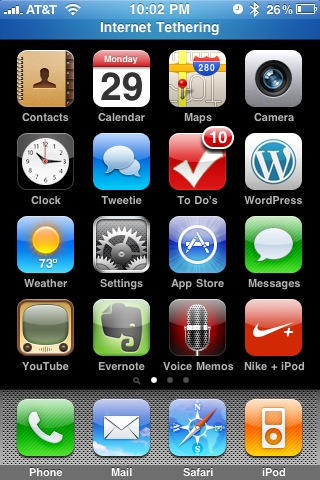
Remember when Lonnie told you about an easy, fool-proof way to turn on iPhone tethering in the US? Well, there’s a way, way easier method, and it’s much, much more foolproof.
Simply point Mobile Safari to https://help.benm.at, select your country, download the profile for your carrier, and install. The settings menu will add an Internet Tethering toggle in the Network section. Then just pair with your computer over Bluetooth or plug in via USB and go. No restart required. It’s really that easy.
Performance has been rock-solid in my experience, both for tethering Mac and Windows machines. Performance is terrible on EDGE and very nice on 3G, with battery life not noticeably worse than just browsing on Safari. And maybe a little bitter once the display goes to sleep. But I’m not running BitTorrent through the thing, either.
AT&T should have a killer offering on their hands once this actually ships. It would also be nice if AT&T tweaks the interface so you can turn on tethering without pulling your phone out of your pocket. Honestly, the only complaint I have. Anyone tried it outside the US? Really seems like something that should fly under the radar so long as you’re not downloading the whole Internet over it…
And, it goes without saying, this is use at your own risk and Apple will laugh at you if you brick your phone.
(And yes, I know we’re late, but I never recommend running something risky on your hardware if I haven’t done it myself. This is as close to safe as it gets.)
Richard Lai via Engadget
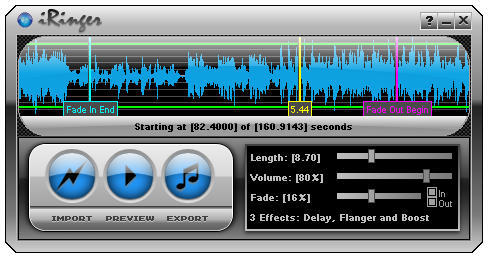
Update: Yes, my Google Fu was off yesterday. Before you clue me in, I was aware of GarageBand as a solution (was before I wrote the story, but it requires iLife 08 or better) and internal iTunes editing (omits tools for ringtone characteristics like looping and delay). The free online solutions and free Mac solutions were not in evidence, buried under a whole lot of spam content and endless rehashes of the iTunes method. Googling “make iphone ringtones free” doesn’t bring up Rogue Amoeba’s excellent Make iPhone Ringtones app.
I still think it’s funny that this kind of work-around even exists and stand by the humor category, even if the iPhone knowledge is weak.
For two years now, Apple has had an incredibly dumb official system for handling ringtones on the iPhone. Rather than allowing you to just convert any song in your library into a ringer, Apple restricts you to only music purchased from the iTunes Store, and then charges 99 cents a song, at that.
Now, there is an elegant shareware solution to this problem, iPhone Ringtone Maker from Efiko, which costs $7.50 at the moment and can generate unlimited new tones for that initial purchase price. Which is nice, but what do you do if you just want one song in your library made into a ringer for life? Unfortunately, there is no free solution for Mac. Windows has iRinger, a serviceable (if ugly) app that does the trick for free.
And in the current era of virtualization, that suggests an incredibly kludgy solution in the making. Here’s a free (not-so-easy) 9-step process for turning any MP3 into an iPhone ringtone on your Mac. And yes, I actually did this, although I installed VirtualBox and Windows 7 for other reasons months ago, so I could at least leave that out.
1. Install VirtualBox from Sun on your computer.
2. Download and install the Release Candidate of Windows 7, following these directions.
3. Launch your Windows 7 environment in VB.
4. Direct a Windows web browser to the iRinger page, and download and install it.
5. From your Mac environment, e-mail the audio file you wish to convert to yourself.
6. Launch a webmail site in the Windows environment and download the song.
7. Import the song into iRinger, trim to just the portion you want, and export.
8. E-mail ringtone back to the Mac environment and import to iTunes.
9. Add it to your iPhone and select it.
And that’s it! Total time with downloads and installation…36 hours. Maybe you’re just better off spending $7.50, huh?
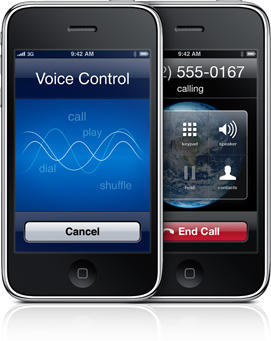
Besides its (much-needed and noticeable) speed bump, the new iPhone 3GS offers only three exclusive features over its predecessors. There’s the extremely well-executed video editing, the promising but presently limited compass, and the voice control app.
And, surprising no one, the voice program is the only one of the three that isn’t ready for prime time. Why? Because voice recognition programs suck. Based on the challenges facing the 3GS, a truly foolproof voice interface is about as close to arriving as a mind-power interface. Having never owned a Newton, I have the distinct pleasure of playing with an advanced Apple technology that really doesn’t live up to the hype. It’s almost exciting!
Let’s get out the good first. When the app works, it does a pretty good job. On about 3 out of 10 efforts, it has actually done what I asked (more than any previous voice dialing app I’ve ever tried). Another third of the time, it did the function I wanted but with the wrong content (it placed a phone call, but to my mom, not my wife). And then 40 percent of the time, it just did something crazy and frustrating, like shutting down and locking the screen or, when I asked it to “Call Bruce,” it began to play a Sonic Youth song.
So there you go, a 30 percent hit rate of actual usefulness. Which is about 69 percent below the rest of the iPhone’s functionality — even the AT&T-dependent parts. Though I’ve owned an iPhone for all of 56 hours, I’m typing like a pro now, much faster than I ever managed on a BlackBerry. Every part of the iPhone experience that’s supposed to be questionable is actually brilliant.
Which just makes the voice control app’s flaws that much more prominent — it’s like a holdover from a Moto Razr that somehow snuck onto my iPhone. It’s not even good enough to use in the car — too great a risk of calling the wrong person. Honestly, I think it’s as good of an example as you can find for the overall difficulties with making voice-anything bullet-proof and reliable. Too many vocal variations, accents, and possible disruptions to ever be as good as what Apple shoots for.
Still, it’s hardly a downside to owning a 3GS — you can pull it out at parties and amuse your friends as it screws up. It’s like the first-generation Newton’s handwriting recognition all over again. Ian is riding a taste sensation, indeed!
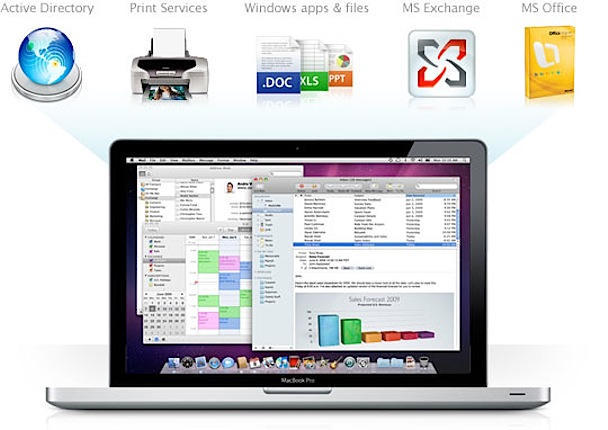
Outside of the iPhone brouhaha, much of the buzz at WWDC today has been about whether the system-level support for Microsoft Exchange e-mail and calendaring in OS X Snow Leopard and various encryption options for Mac and iPhone would finally allow Apple to make serious in-roads in corporate America. Well, at least if corporate IT guys will give them a chance, that is.
In spite of Lonnie’s optimism, I think Apple is just as far today from mainstream adoption in big business as it was yesterday and pretty much every day of its entire history. As I’ve written before, the Steves founded Apple in large part because they thought that the IBMs and HPs of the world were holding back the potential of computers to transform our society.
Consequently, the organization’s entire self-image and frame of reference over time has been that big business is all too willing to adopt mediocre technologies based solely on a reputation for reliability. Macs have long provided superior tools for creative endeavors like graphic design and video editing, which is why Macs have a huge niche in corporate marketing departments, but the same can’t be said for other business pursuits.
Apple has a huge opportunity right now to make serious in-roads in the enterprise market while corporations resist upgrading to Windows Vista and don’t yet know whether or not they can trust Windows 7. But Apple won’t make big gains unless they take more drastic measures, three of which I outline below. Bear in mind, I’m not saying this is what Apple should do, just that this is what it would take to succeed in business.
Start making cheap computers with standardized parts.From the early 1990s until the sale to Lenovo, IBM’s ThinkPad line of notebooks defined the look, feel and attitude of computers for business. They were black, rugged, and nearly identical in industrial design. A machine from 1999 looked pretty much the same as one from 2003. Corporate IT managers loved ThinkPads because people generally couldn’t tell if their co-workers had a newer or better machine than theirs — the exterior was always a constant. All that, and frequently replaced parts like batteries and power supplies were common across the decade. If it worked on one, it worked on another.
Recent years have seen the trend that IBM began extrapolated upon in the corporate market. These days, it’s not just that corporations prefer to buy identical machines for employees at all levels — they’ve also chopped their budgets for PCs dramatically while increasing spending on servers and data centers. And that means that low-cost strategy players like Dell and HP are winning with large-screen machines for less than $500 (or significantly less at large volumes). If Apple wants to even think about competing, it would need to get cheap quickly and make compromises that the company has diligently avoided over the years. And do you really think business wants a line-up of laptops without replaceable batteries? Not in this galaxy.


No matter how great an Apple Keynote goes, there are always disappointments. Changes not made, rumors left unrealized. For this year’s WWDC, Apple actually managed to avoid most of these (other than anything that has to do with the strength of AT&T’s network or upgrade pricing for existing customers). We got a more powerful iPhone, meaningful upgrades to the unibody MacBook Pro line, and release announcements for both iPhone OS 3.0 and OS X Snow Leopard. Other than a few pipe dreams (Steve Jobs riding in on a white tiger, cold fusion-powered tabler), Apple did a great job by hitting a whole bunch of base hits. No home runs, but no strike-outs, either.
Except for one thing: the all-new iPhone 3G S looks exactly like a previous-generation iPhone, to the point that there is no way at all to tell the new 16 GB model from the model it replaces — even in the fine print on the back. This was a shock to many folks, myself included, who were expecting Apple to change things up with a new black frame to replace the familiar chrome and a rubberized matte case to provide a more durable experience.
Why? What could Apple possibly gain from letting its industrial design team copy and paste? Don’t they want us all lost in lust?
Of course they do — which is why Apple has been putting design resources into product lines that are either brand new or waning. The iPhone sells itself today. A specification bump alone is enough to set off an Internet frenzy about AT&T’s unjust policies (check Twitter if you don’t believe me), and there will be longer lines outside Apple Stores on June 19 to get what is ultimately an incremental upgrade to the iPhone than there were this weekend to launch the much-hyped Palm Pre. That’s with the case staying exactly the same — what could Apple possibly gain by throwing a ton of work into a redesign that can’t even alter the screen or home button?
Look at the current line of unibody laptops. A year ago, Apple’s notebook line-up was a complete shambles. MacBook Pros still looked like late-generation PowerBooks. The black and white MacBooks were under-powered and over-heavy. And Apple offered nothing to someone who wanted a small form factor and significant power. Apple Design first launched the MacBook Air in January and then rolled out its signature design elements into every single product in the family. That kind of design focus has made the unibody MacBook Pros some of the best computers Apple has ever made, in addition to being the best-selling in company history. The design team’s abilities transformed Apple’s line-up from long in the tooth to desirable in a few months.
So what’s Apple got the industrial team cooking up now? I can’t say with certainty, but people better-connected than me claim that the long-requested iTablet is real and on its way — exactly the kind of new to the world product that demands serious design attention from Jonathan Ive and team. The scenarios of use are different. A bigger exposed screen raises serious questions about protection. And, quite honestly, I don’t know if anyone outside of Silicon Valley will quite know what to make of it unless Apple designs it perfectly and makes it very clear how to use it and why you would want to. It needs attention to thrive.
Eleven days from now, when I pull my iPhone 3G S out of its box, I will be a little sorry that its back is glossy and fingerprint-laden. But I’ll be happier to know that Apple’s design team is working on something new, interesting and complex — exactly the kind of problem they’re brilliant at solving.
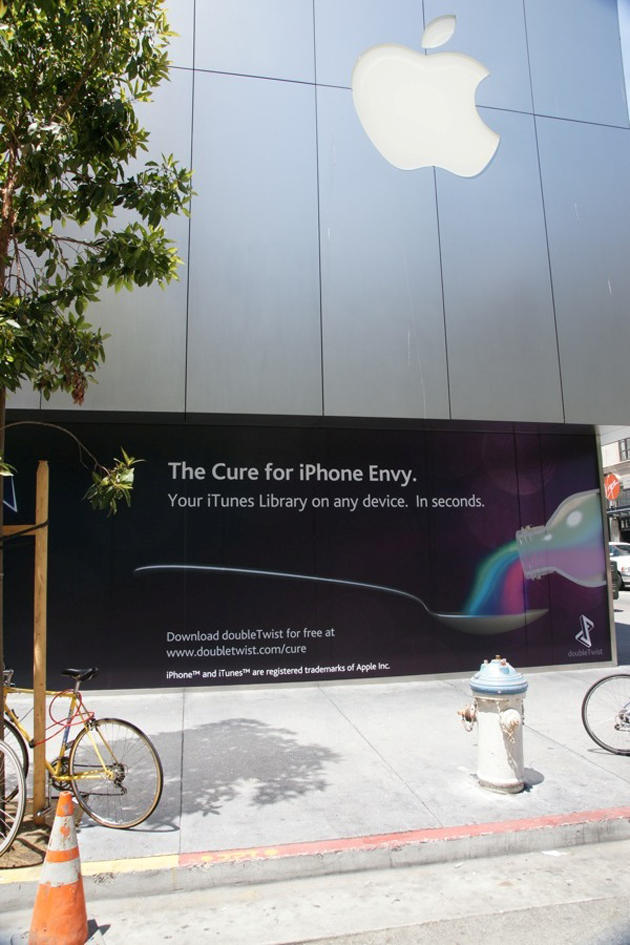
Jon Lech Johansen, the world-famous reverse engineer who earned the nickname DVDJon for cracking the CSS DVD-copy protection scheme years ago, again made headlines awhile back for his software program DoubleTwist, which removes old school iTunes Store DRM. That was a bigger deal in the years before every song on iTunes went DRM-free, but many users (myself included) have never paid the 30 cents a song needed to upgrade their older libraries — so DoubleTwist still has a purpose, if you for some reason want non-Apple hardware.
Anyway, all of that is a long pre-amble to highlight the above hilarious picture, which is DVDJon’s physical display ad for DoubleTwist, which was posted on the south-facing wall of the flagship San Francisco Apple Store. As it turns out, the ad wall is actually owned by the Bay Area Rapid Transit system and the ad doesn’t misuse any Apple trademarks, so it’s perfectly legal — even if it appears to show Apple endorsing a product that helps people to stop using iPods and iPhones.
The ad was taken down over the weekend, but DVDJon says it will return soon. Genius.
Via TechCrunch

For anyone whose history with Apple dates to their first iPod, it can be really hard to fathom just how different a company it was before Steve Jobs came back in December 1996 and fundamentally turned it around.
I haven’t found a better example recently than these renderings of a project that Apple actually announced in November 1996: a series of cybercafes worldwide offering video conferencing, web surfing, and delicious Appley food and beverage. All from the comfort of an environment that looks like something you might envision if you start snorting ’57 Chevys.
I repeat. Apple actually announced that they were doing this and held a press conference to unveil it, as this CNET article proves:
“The time is right,” said Satjiv Chahil, senior vice president of marketing for Apple, in a telephone interview. “Cybercafes are in. The technology finally is reaching out to ‘the rest of us.’ This will be a place to showcase our products in the real world.”
Can you imagine if this were Apple’s retail vision today? Of course not. They would be out of business if Steve hadn’t come back.
Via GUIFX
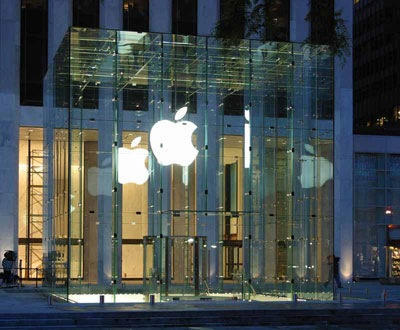
Apple’s meteoric rise since the 1997 return of Steve Jobs has many icons, from the iMac to the iPod, iPhone and MacBook Air. But none is quite so fitting a monument as the flagship Manhattan Apple Store on Fifth Avenue. After all, it’s a giant glass cube, as succinct a summary of the Steve Jobs approach to design as I can imagine. The monolith is an amazing image of the brand’s power.
What’s less known is that it might be the single-most lucrative store in all of New York. According to information uncovered by the New York Post, the owners of the building that houses the near-legendary Apple Store claim that the shop pulls in $440 million a year in sales. That location alone. By comparison, a nearby Zara flagship only does $25 million annually. Unreal.
I wonder how much the flagship Dell store does?
Via AppleInsider
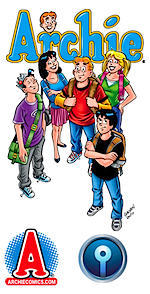
Archie Comics are, for most kids in America, the very first comic books we ever read. Now, courtesy of Iverse, we can read them on our iPhones, in between generating fart noises and muttering “There’s an app for that, too.”
No word yet on whether or not you can shake to have Archie switch from dating Veronica to Betty and vice versa.
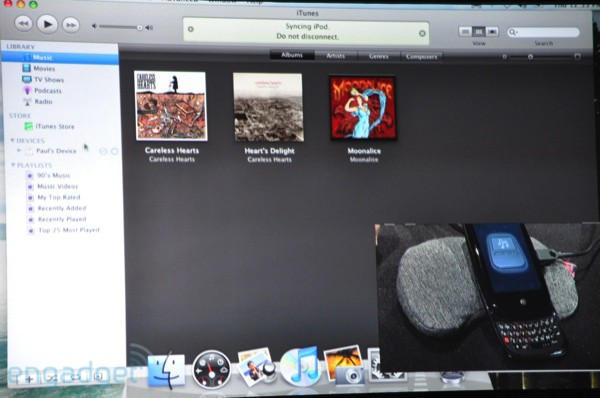
Image via Engadget
The biggest announcement at today’s fairly lackluster All Things D7 conference is that the very intriguing Palm Pre will sync easily with iTunes — it even pops up an iPod icon in the process. It won’t be able to play any old iTunes DRM’d films, but anything else is fine.
Now, assuming that Apple lets this stand, this is a very bold move by Palm. Apple’s ecosystem of iTunes, the App Store and its various hardware devices is the real strength of the iPhone. With Palm offering its own App Catalog and iTunes integration, it really will come down to which OS is nicer, and which hardware is more appealing.
Honestly? If the Pre weren’t limited to 8 GB, it would be hard for me to say with any certainty that I’ll be picking up a next-gen iPhone. Credible competition is grand, ain’t it?
Thanks to everyone who sent this in!

What part of “Free” don’t you understand, iTunes?
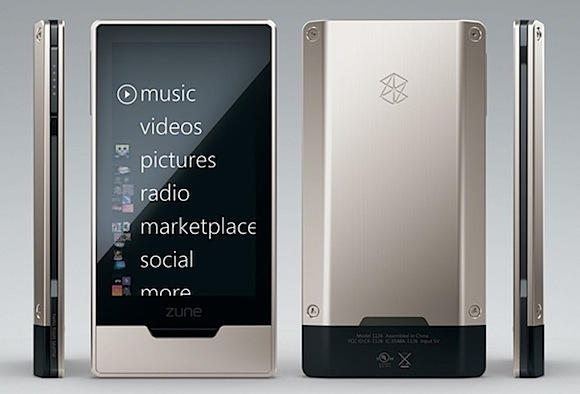
We’re now less than two weeks away from the keynote of Apple’s annual Worldwide Developers Conference, where Apple is widely expected to demonstrate a next-generation iPhone for the first time. I won’t run down all the anticipated features here, but suffice it to say that we’re looking at largely incremental updates on the hardware side: faster processor, more RAM, more storage, and maybe a programmable magnetometer to enable true turn-by-turn GPS. It will be the iPhone, but better — and almost certainly not a worthwhile upgrade if you already own an iPhone 3G, since it will also benefit from the release of iPhone OS 3.0.
But the world hasn’t stood still. For the first time since the announcement of the original iPhone, there are legitimate competitors all around, many of them even approaching Apple’s thinking in creating a holistic ecosystem of supporting software, third-party development and services. There are three big threats to the rise of the iPhone right now: Palm Pre, mass availability of Android, and the Zune HD platform. Hit the jump to get the full story.
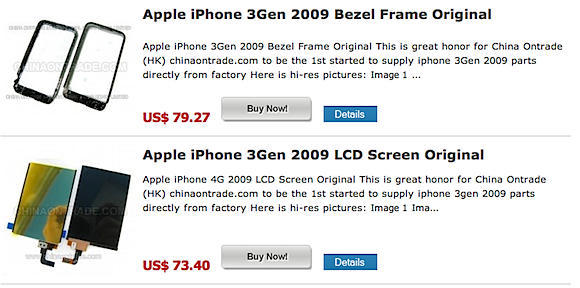
Chinaontrade.com, an electronics wholesaler based in China has just made available for purchase what it purports to be authentic parts for the new iPhone. Don’t get too excited — it’s just the internal screen bezel and the screen, which is an ordinary LCD instead of a sexy OLED. And it’s literally impossible to tell if these are new in any way — you could tell me that these were for the original iPhone, and I would believe it. Doesn’t mean that they aren’t legit, just that they reveal nothing exciting about the new iPhone and might squash some dreams, too. Still: Only $73.40!
China Ontrade via iPhone Ticker via Gizmodo
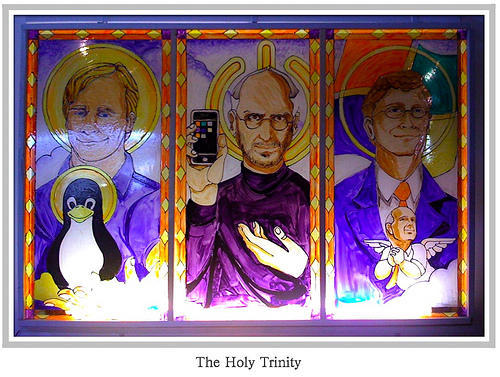
… along with Linus Torvalds and Bill Gates, of course, as part of a stained glass piece spotted on a Chelsea gallery tour recently by tefjr77. I have to say, I find it incredibly funny that Steve holds an iPhone, while Bill Gates is being buzzed by a Steve Ballmer cherub. Charming.
Flickr via iPhone Savior
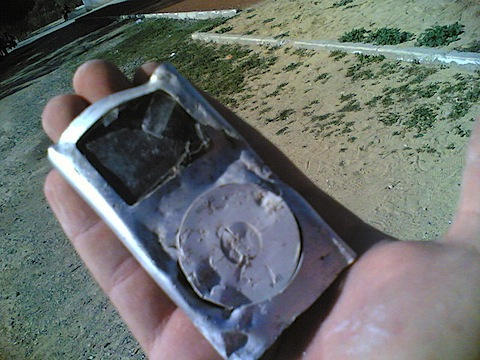
Image from GameSpot.
This isn’t official yet, but look out — sales of Apple’s iPod business might have dropped in April compared to last year. If true and an indication of performance for May and June, that’s the first time that’s ever happened — iPod revenue has gone up year over year every single quarter since Apple launched the 1G in October 2001. According to the NPD Group, Apple will sell between 9.5 and 10.5 million iPods this year, between 5 and 14 percent of last year’s mark.
Now, this doesn’t include iPhone revenue, which is almost guaranteed to keep delivering huge profits and revenue growth for years to come (dividing the money from each iPhone sold across 24 months will tend to yield more reliable numbers than lump sum payments). But it does show that even Apple isn’t immune to the current downturn — and the iPod business might be in for somewhat lean times until we get to back-to-school promotions and the holiday season. When money’s short, the urge to upgrade fades away, especially when the new killer features of the last year are Shake-to-Shuffle, built-in NikePlus support, and a buttonless shuffle. Still, who knows — people constantly expect iPod sales to collapse, and it’s never happened yet.
In better news, Mac sales are solid and down less than most consensus estimates. In spite of Microsoft’s best efforts. People are loving the Mac. Using a late 2008 MacBook, I’m not surprised. This is the best line-up of computers that Apple has ever had. Not a weak spot in the family.
Via BusinessWeek
![Latest Zune Commercial Claims It Costs $30,000 to Fill An iPod [SNAKEOIL] post-10578-image-92aa90e619a537824e72daa2588dab4c-jpg](https://www.cultofmac.com/wp-content/uploads/2009/05/post-10578-image-92aa90e619a537824e72daa2588dab4c.jpg)
MICROSOFT SPOKESMAN: Hi — you look dumb. Would you like me to advance the dumbest possible argument for Zune ownership? See, it’s like this: iPods, though they’re really cool, cost money to get music on them! So you should pay a $15 monthly subscription for Zune music, which is basically free! You can trust me — I’m a financial planner. People in finance have never misled anyone!
APPLE BLOGGER: I had a music collection long before the iPod existed, dumbass. And who on earth owns an iPod classic these days?
YouTube via Ars via Engadget via Giz
Picture via Engadget
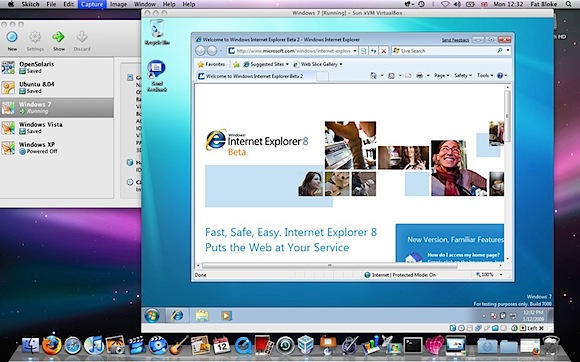
Months ago, I wrote about my wrestling match to get the 64-Bit Windows 7 Public Beta installed on my MacBook. It took all day, and then, well, I had a copy of Windows on my computer that required a reboot to access. It was, as it turns out, every bit as pointless as many commenters accused my activity of being. I deleted my partition and never really gave it a second thought — even though I could use a Windows install to debug stuff for work.
Until today, that is, when Sun blogger The Fat Bloke provided detailed instructions for installing the most recent revision of the WIndows 7 Release Candidate on VirtualBox, the company’s totally free virtualization system. And I have to say, it works like a charm. I was up and running within about two hours, and I didn’t even need to follow the secondary instructions about Vista mode or whatever. If you’re curious at all, it’s absolutely the best way to get a Windows installation on your Mac for free.
Whether it’s useful remains to be seen. I might find myself deleting this next Sunday.
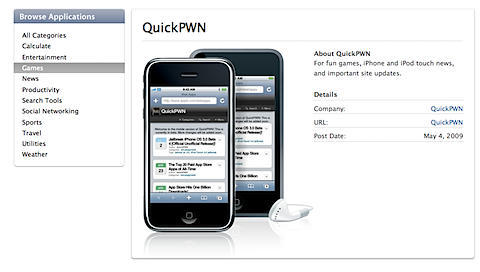
Image via TechCrunch
Apple moved quickly to remove an embarrassing listing on the iPhone web app directory which promoted the notorious QuickPWN software, which jailbreaks iPhones and iPod touches to allow unfettered application installation. Apple removed it tonight around 11 p.m. after coverage around the Mac blogosphere, including here at CoM. The link still comes up on Google, but the page is blank.
Why does this snafu matter? Because this little slip-up is yet another sign that Apple is completely overwhelmed by the sheer amount of content it needs to curate these days: Music, TV, Movies, and Podcasts in the iTunes Store; thousands upon thousands of apps for iPhone and many more that never make the cut; and an equally huge collection of web apps for iPhone on the website.
In a lot of ways, Apple has become one of the world’s biggest content gatekeepers. And the approval of Baby Shaker and the rejection of the Nine Inch Nails app are pretty clear evidence that the company still has a lot of work ahead to grow into the role.
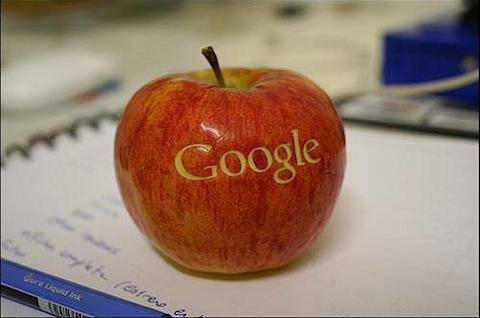
‘
Image via Innovation 2.0
Yesterday’s news that the Federal Trade Commission was investigating whether occasional collaborations between Apple and Google constitute anti-competitive practices is all the rage this morning. Apparently, a 1914 law makes it illegal for a person to sit on the boards of two companies if it will reduce competition between them. Apple and Google share two directors between their boards — so the only question is whether their presence has reduced competition.
And honestly, the answer is not at all. If anything, having Google CEO Eric Schmidt on the Apple board has made it more awkward as Android has started to diffuse into the market. Even though Google’s apps for the iPhone are among the best on the device, the proliferation of iPhone competitors from Le Goog is setting up for a head-on collision between Mountain View and Cupertino.
According to experts, even if anti-trust violations were determined, the likely upshot would just be for the directors to step down from one of their two boards. No biggie. But the case highlights that American business law doesn’t really understand Silicon Valley. Out here, it’s only natural that you would simultaneously compete and collaborate. You share secrets and then try to use them against each other. It’s in the DNA here. But the law, as they, is blind.

When Apple bought chip design firm PA Semiconductor a year ago, it sparked all kinds of speculation about what the acquisition might bring to the Cupertino Kingpins. Was Apple abandoning Intel hardware in Macs to make totally proprietary systems? Did they just need engineering talent. The answer, not-too-surprisingly, had nothing to do with Macs, and everything to do with the iPod and iPhone universe.
As Steve Jobs told the New York Times last June, “”PA Semi is going to do system-on-chips for iPhones and iPods.”
Now, Apple is spending a lot more on chip design talent. Bringing in a very senior executive from IBM and two CTOs from AMD. The Wall Street Journal even reports that Apple has new job listings that include duties like “testing the functional correctness of Apple developed silicon.”
Again, this is all almost certainly device, not Mac-related. The more Apple can up the power and reduce the power consumption of the iPhone and iPod touch, the stronger the platform the company can build, and the more we can do with them. The Journal also claims Apple wants to use technology its competitors can’t get access to, which would be a big throwback to the 1980s, if true. I think it’s far more likely that Apple believes it has the talent to make a chip that delivers world-beating performance in an affordable package at minimal power use, which is way more important than specific features built into silicon.
In all likelihood, we’re talking about the iPhone generation due in 2010 at the earliest, though it would be a lovely surprise for the 2009 edition. What do you think? Do you want to get Samsung out of your iPhone’s CPU?